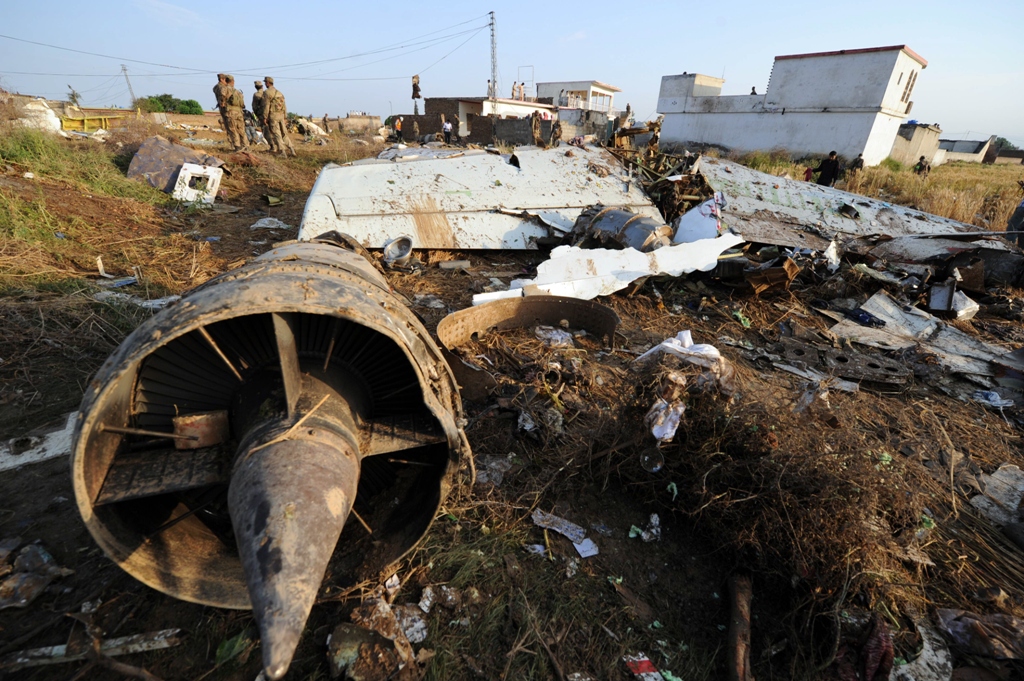
Bhoja Air’s flight BH-213 crashed in April 2012 due to multiple factors including the airline’s failure to realise that its pilots were improperly trained to fly the specific jet and the regulator’s oversight, a Judicial Commission found after an eight-month enquiry.
All 127 people on board died in the plane crash in rural Islamabad in what was Bhoja’s maiden flight from Karachi.
The commission, which was formed on the orders of the Islamabad High Court after a petition was filed by relatives of the deceased passengers, included Justice (retd) Ghulam Rabbani and a technical member Air Vice Marshal (retd) Faaiz Amir.
A 138-page report was prepared based on multiple interviews of airline officials, Civil Aviation Authority (CAA), law enforcement agencies and an analysis of relevant documents including the official investigation report into the crash.
The report, a copy of which is available with The Express Tribune, also notes that the captain’s insistence to fly through a thunderstorm and “abnormal behaviour” of the airplane also contributed to the crash.
It primarily sought to find answers to seven broad questions including the background in which the airline was issued the licence and fixing responsibility for the incident.
“Commission finds the operator Bhoja Air, the regulator CAA, the flight crew and the airplane falling short on the tasks attributed to them on a number of counts,” the report says.
Multiple discrepancies were found on part of the airline. For instance, two months before the crash, a CAA officer informed superiors that the airline was “physically bankrupt” with a negative equity of Rs8.1 million.
Additionally, the condition to have at least three aircraft on dry lease for a start-up airline was not followed as one of the planes, a DC9-32, was inducted on wet lease, which is normally used as a temporary arrangement.
The commission noted that Arshad Jalil – Shaheen Air’s former chief executive officer – bought majority shares in the airline from Farouk Bhoja who said he was never paid the agreed amount. Farouk was not pressed by the commission as he had nothing to do with the airline affairs.
A major oversight also related to the ill-fated flight’s Captain Noorullah Afridi who was found to be below-par in 55% of the essential exercises during the Flight Simulator Proficiency Check in January 2012.
The commission, like the crash investigation report published by The Express Tribune earlier this year, found that Captain Afridi was not adequately trained to use an automated flight deck that was installed on the Boeing 737-236A — an advanced version of the 737-200 that he was flying.
Bhoja’s management did not even incorporate the Boeing recommended inflight procedures, leaving the crew to follow the procedures of the older variant of the jet.
“The failure on part of the operator Bhoja Air in knowing well the airplanes that it brought to operate in the country resulted in absence of required ground and flight training and documentation for the flight crew,” the commission said.
First Officer Javed Malik was not even sent for the simulator training on B 737-236A. Instead, the CAA gave an extension in the validity of the training period not realising he would be co-piloting a completely new type of plane.
While the weather was fine in Islamabad when the flight took off from Karachi on the evening of April 20, 2012, the Met Department reported a thunderstorm over Benazir Bhutto International Airport an hour later.
This should have been communicated to the flight crew by Bhoja Air’s dispatch service, which keeps track of weather at destination and alternative airports, the commission says.
Transcript of the Cockpit Voice Recorder (CVR) revealed that the captain took a casual approach towards adverse weather condition and was bent upon landing in Islamabad. The commission notes this was the most important factor contributing to the accident.
Analysis of the last three minutes of the flight when it encountered windshear, an adverse weather condition, reflects unfamiliarity of the crew with automated flight deck of the aircraft as it did not follow standard procedure.
Published in The Express Tribune, October 1st, 2014.
COMMENTS (15)
Comments are moderated and generally will be posted if they are on-topic and not abusive.
For more information, please see our Comments FAQ

1732530816-0/BeFunky-collage-(88)1732530816-0-165x106.webp)
1720848500-0/Eminem-and-his-daugher-Hallie-(1)1720848500-0-165x106.webp)




1732529980-0/Copy-of-Untitled-(84)1732529980-0-270x192.webp)

1732530440-5/Copy-of-Untitled-(85)1732530440-5-270x192.webp)







Waiting impatiently for expose of Arshad Jalil and family in poorly managing the airline. I hope ET does more stories on them.
This article is full of incorrect details and lacks fair judgment of the whole story.
Just for facts : 1) Airline was not bankrupt. Check the airline's passenger load details from CAA , you will have an idea. 2) It was not the maiden flight to Islamabad 3) The age of the aircraft has nothing to with it safety. 4) The airline was in complete coordination with Boeing. 5) Mentioning incorrect competence levels for pilots is made up figure on part of the author of this article.
@omar jalil: Please contact us. We have been trying to do that for quite some time. You are absolutely right. Any discrepancies in the way the document was analyzed will be corrected.
The concept that 236 requires a special simulator is absurd....The number 36 is the customer number of who bought this -200 aircraft. Today the same simulator is used for-300 to -900, what to talk of variants within each model. In this specific instance however both pilot and Co pilot were trained on a -236 simulator as their training was conducted on an ex British airways simulator, the original buyer of the ill fated aircraft. Although I'm not defending the captains competence but claiming the captain was sub par on 55% of training is simply a made up number Thirdly getting an aircraft on wet lease to complete the 3 aircraft requirement was and remains a legal practice....why it is being shown aa a conspiracy theory is beyond me...... The list of errors in this sub par piece of journalism are endless....Sadly my time is not..... Good day
**"A major oversight also related to the ill-fated flight’s Captain Noorullah Afridi who was found to be below-par in 55% of the essential exercises during the Flight Simulator Proficiency Check in January 2012."
"First Officer Javed Malik was not even sent for the simulator training on B 737-236A. Instead, the CAA gave an extension in the validity of the training period not realising he would be co-piloting a completely new type of plane."**
CAA Pakistan Should Investigate their own Licencing Department first.
Imran khan please let the country progress under Nawaz Government.. A message from Ex PTI worker
This is criminal negligence on part of Bhoja Air and CAA. Are we going to see some indictments on Bhoja Air executives and CAA management ?
This is news from January 2014? Has ET recycled and republished the same report? :S
@Omar Jalil, You seems to be son of Arshad Jalil the owner of Bhoja Airline, can you share your version of story here?
Can you please share your first hand information here with us?
Perhaps there was a foul play from foreign forces? The Malaysian Air lines are a good example, one vanished without a trace.
Rex Minor
I happen to have first hand information about the incident. Sad to see biased report and a subsequently inaccurate article.
And what will happen next...Nothing as usual...
If a grounded airplane can be declared flying worthy and crashes on its first flight then there is no need to look anywhere but at the people who cleared it in the first place.
Anybody being punished??? if no then it was a useless exercise.
Absolutely criminal-precious lives lost with no accountability; issue needs to be raised at a proper platform and all those responsible needs to be severely punished so that it can be a lesson for all-unfortunately in a country like Pakistan where all illegal practices take place on the basis of money; implementation of SOPs in true sense leaves behind a big question mark....the systems and people constituting and implementing the systems needs a change!